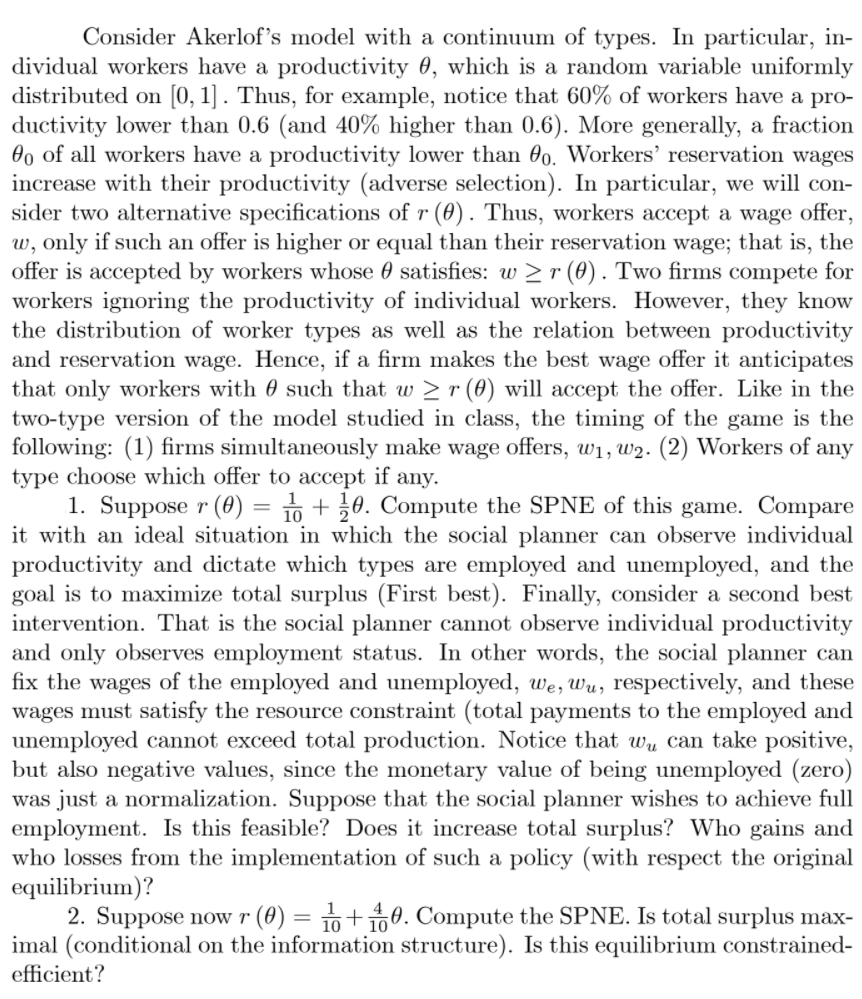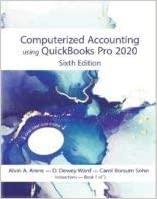
Consider Akerlof's model with a continuum of types. In particular, in- dividual workers have a productivity 0, which is a random variable uniformly distributed on [0, 1]. Thus, for example, notice that 60% of workers have a pro- ductivity lower than 0.6 (and 40% higher than 0.6). More generally, a fraction 00 of all workers have a productivity lower than 60. Workers' reservation wages increase with their productivity (adverse selection). In particular, we will con- sider two alternative specifications of r (@). Thus, workers accept a wage offer, w, only if such an offer is higher or equal than their reservation wage; that is, the offer is accepted by workers whose 6 satisfies: w >r(@). Two firms compete for workers ignoring the productivity of individual workers. However, they know the distribution of worker types as well as the relation between productivity and reservation wage. Hence, if a firm makes the best wage offer it anticipates that only workers with @ such that w > r (0) will accept the offer. Like in the two-type version of the model studied in class, the timing of the game is the following: (1) firms simultaneously make wage offers, w1, W2. (2) Workers of any type choose which offer to accept if any. 1. Suppose r (0) = 1 + 20. Compute the SPNE of this game. Compare it with an ideal situation in which the social planner can observe individual productivity and dictate which types are employed and unemployed, and the goal is to maximize total surplus (First best). Finally, consider a second best intervention. That is the social planner cannot observe individual productivity and only observes employment status. In other words, the social planner can fix the wages of the employed and unemployed, we, Wu, respectively, and these wages must satisfy the resource constraint (total payments to the employed and unemployed cannot exceed total production. Notice that w, can take positive, but also negative values, since the monetary value of being unemployed (zero) was just a normalization. Suppose that the social planner wishes to achieve full employment. Is this feasible? Does it increase total surplus? Who gains and who losses from the implementation of such a policy (with respect the original equilibrium)? 2. Suppose now r (0) = 1+ 10. Compute the SPNE. Is total surplus max- imal (conditional on the information structure). Is this equilibrium constrained- efficient? Consider Akerlof's model with a continuum of types. In particular, in- dividual workers have a productivity 0, which is a random variable uniformly distributed on [0, 1]. Thus, for example, notice that 60% of workers have a pro- ductivity lower than 0.6 (and 40% higher than 0.6). More generally, a fraction 00 of all workers have a productivity lower than 60. Workers' reservation wages increase with their productivity (adverse selection). In particular, we will con- sider two alternative specifications of r (@). Thus, workers accept a wage offer, w, only if such an offer is higher or equal than their reservation wage; that is, the offer is accepted by workers whose 6 satisfies: w >r(@). Two firms compete for workers ignoring the productivity of individual workers. However, they know the distribution of worker types as well as the relation between productivity and reservation wage. Hence, if a firm makes the best wage offer it anticipates that only workers with @ such that w > r (0) will accept the offer. Like in the two-type version of the model studied in class, the timing of the game is the following: (1) firms simultaneously make wage offers, w1, W2. (2) Workers of any type choose which offer to accept if any. 1. Suppose r (0) = 1 + 20. Compute the SPNE of this game. Compare it with an ideal situation in which the social planner can observe individual productivity and dictate which types are employed and unemployed, and the goal is to maximize total surplus (First best). Finally, consider a second best intervention. That is the social planner cannot observe individual productivity and only observes employment status. In other words, the social planner can fix the wages of the employed and unemployed, we, Wu, respectively, and these wages must satisfy the resource constraint (total payments to the employed and unemployed cannot exceed total production. Notice that w, can take positive, but also negative values, since the monetary value of being unemployed (zero) was just a normalization. Suppose that the social planner wishes to achieve full employment. Is this feasible? Does it increase total surplus? Who gains and who losses from the implementation of such a policy (with respect the original equilibrium)? 2. Suppose now r (0) = 1+ 10. Compute the SPNE. Is total surplus max- imal (conditional on the information structure). Is this equilibrium constrained- efficient







